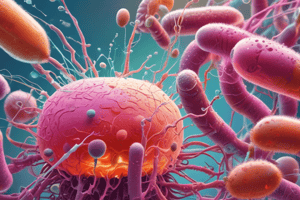Podcast
Questions and Answers
What is the primary advantage of autoclaving in the sterilization process?
What is the primary advantage of autoclaving in the sterilization process?
- It requires no water or moisture in the process.
- It uses radiation to kill bacteria.
- It sterilizes items overnight without any temperature increase.
- It utilizes steam pressure to increase temperature and decrease sterilization time. (correct)
Which temperature is typically achieved in an autoclave for effective sterilization?
Which temperature is typically achieved in an autoclave for effective sterilization?
- 100°C
- 121.5°C (correct)
- 150°C
- 62.9°C
What is the process known as fractional sterilization primarily aimed at?
What is the process known as fractional sterilization primarily aimed at?
- Eliminating liquid pathogens instantly.
- Intermittent exposure to steam to kill spores over several days. (correct)
- Using only chemical agents to achieve sterilization.
- Maintaining an unchangeable temperature for long durations.
Which of the following is a correct description of pasteurization?
Which of the following is a correct description of pasteurization?
In fractional sterilization, what happens after the initial exposure to steam?
In fractional sterilization, what happens after the initial exposure to steam?
Why is steam pressure critical in the autoclaving process?
Why is steam pressure critical in the autoclaving process?
Which microorganism is targeted specifically during pasteurization?
Which microorganism is targeted specifically during pasteurization?
Flashcards
Autoclaving
Autoclaving
A sterilization method using pressurized steam to rapidly heat and kill microbes, including resistant spores.
Autoclave pressure
Autoclave pressure
The pressure inside an autoclave, typically 15 pounds per square inch above atmospheric pressure.
Autoclave temperature
Autoclave temperature
The minimum temperature required for effective sterilization in an autoclave, usually 121.5°C (250°F).
Fractional sterilization
Fractional sterilization
Signup and view all the flashcards
Fractional sterilization step 1
Fractional sterilization step 1
Signup and view all the flashcards
Fractional sterilization step 2
Fractional sterilization step 2
Signup and view all the flashcards
Pasteurization
Pasteurization
Signup and view all the flashcards
Study Notes
Autoclaving
- Uses steam pressure to increase sterilization temperature and reduce time.
- Maintains pressure 15 lb/sq inch above atmospheric pressure.
- Superheats water molecules to at least 121.5°C.
- Rapidly transfers heat to items (up to 15 meters).
- Commonly used to sterilize culture media, glassware, and metalware.
Fractional Sterilization (Tyndallization)
- Performed in a cyclical, on-off sterilization process.
- Initial sterilization with free-flowing steam at 100°C for 30 minutes.
- Allowed to cool to let bacterial spores germinate into vegetative cells.
- Resterilized one to three times depending on bacterial growth.
Pasteurization
- Reduces bacterial population of liquids (like milk).
- Heats liquids to 62.9°C for 30 minutes.
- Kills Mycobacterium tuberculosis and Q-fever agents.
Studying That Suits You
Use AI to generate personalized quizzes and flashcards to suit your learning preferences.



